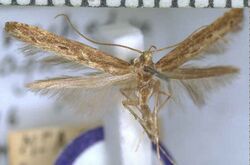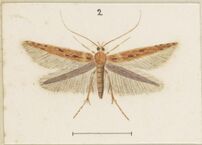Biology:Batrachedra agaura
| Batrachedra agaura | |
|---|---|

| |
| Lectotype | |
| Scientific classification | |
| Domain: | Eukaryota |
| Kingdom: | Animalia |
| Phylum: | Arthropoda |
| Class: | Insecta |
| Order: | Lepidoptera |
| Family: | Batrachedridae |
| Genus: | Batrachedra |
| Species: | B. agaura
|
| Binomial name | |
| Batrachedra agaura Meyrick, 1901[1]
| |
Batrachedra agaura is a species of moth in the family Batrachedridae. It is endemic to New Zealand. This species is distributed throughout the country. The species inhabits native forests, especially beech and kanuka forests or manuka scrubland. The larvae of this species are associated with sooty mold and sooty beech scale. It has been hypothesized that the larvae feed on sooty beech scale. However, they may also feed on the sooty mold itself. The adult female is lighter in appearance than the male, and the species shows considerable variation in patterns on the forewing. Adults are on the wing from October to February. They are nocturnal and occasionally attracted to light.
Taxonomy
This species was described in 1901 by Edward Meyrick.[2] George Hudson discussed and illustrated this species both in his 1928 publication The Butterflies and Moths of New Zealand,[3] and in his 1950 book Fragments of New Zealand Entomology.[4] John S. Dugdale criticized the quality of Hudson's illustrations, arguing that the images were not as brown as specimens of the moth.[5] The lectotype was collected by Meyrick at Mount Arthur below Flora Saddle in the Nelson district.[5] This specimen is held at the Natural History Museum, London.[5]
Description
Meyrick described the species as follows:
♂♀. 13-17 m.m. Head pale whitish-ochreous. Palpi whitish, second joint dark fuscous towards apex, scale-projection slight, terminal joint more or less suffused with dark fuscous except base and apex. Antennae and thorax whitish-ochreous, reddish-tinged. Abdomen ochreous-whitish. Legs dark fuscous, suffusedly ringed with ochreous-whitish. Forewings whitish-ochreous or pale reddish-ochreous, more or less suffused with dark fuscous or dark reddish-fuscous irroration ; plical and first and second discal stigmata large, dark fuscous, plical at 2⁄5 , first discal slightly beyond middle : cilia pale fuscous, on costa ochreous-whitish dotted with dark fuscous, round apex with a black basal line. Hindwings rather dark fuscous ; cilia light fuscous or pale ochreous.[2]
Alfred Philpott described the proboscis of the adult of this species as being long and well-developed.[6] The female of the species is lighter in appearance than the male.[4] The color and markings of this species show considerable variation.[3]
Distribution
This species is endemic to New Zealand.[1][7] Specimens have been collected from Kaeo in the North Island to Invercargill in the South Island and it is regarded as being generally distributed throughout the country.[3] This species has also been recorded at Pitt Island in the Chatham Islands.[8]
Biology and behavior
Adults are on the wing from October to February.[9] They are nocturnal and are occasionally attracted to light.[9] The larvae form a cocoon in their feeding place and pupate there.[9]
Habitat and host species
This moth prefers native forest habitats, especially beech forest and manuka scrubland.[3][9] It is also known to inhabit kanuka forest.[10] The larvae of this species are associated with sooty mold and sooty beech scale.[11] It has been hypothesized that B. agaura larvae feed on sooty beech scale.[11] However, they may also feed on the sooty mold itself.[9] If B. agaura are found to consume scale insects this species will be one of the few that have larvae that are predatory.[9]
References
- ↑ 1.0 1.1 "Batrachedra agaura Meyrick, 1901". Landcare Research New Zealand Ltd. http://www.nzor.org.nz/names/90e2b921-11f3-479d-bc8f-b10017825f00.
- ↑ 2.0 2.1 Meyrick, Edward (1901). "XVII. Descriptions of New Lepidoptera from New Zealand" (in en). Transactions of the Royal Entomological Society of London 49 (4): 565–580. doi:10.1111/j.1365-2311.1901.tb01373.x. ISSN 1365-2311. https://www.biodiversitylibrary.org/page/41672546#page/617/mode/1up.
- ↑ 3.0 3.1 3.2 3.3 Hudson, G. V. (1928). The Butterflies and Moths of New Zealand. Wellington: Ferguson & Osborn Ltd.. pp. 304. OCLC 25449322. http://www.bugz.org.nz/WebForms/ResultDetails.aspx?CurrentDoc=C7E94865-492F-45DA-9777-CC8E1E8B1438&back=true&NewDoc=true&searchType=1&SearchString=G.V.+Hudson.
- ↑ 4.0 4.1 Hudson, George Vernon (1950). Fragments of New Zealand entomology : a popular account of all the New Zealand cicadas : the natural history of the New Zealand glow-worm : a second supplement to The butterflies and moths of New Zealand, and notes on many other native insects.. Wellington, N.Z.: Ferguson & Osborn. pp. 106. OCLC 154155584. http://www.bugz.org.nz/WebForms/ResultDetails.aspx?CurrentDoc=93CFEB68-5CA5-4EBF-8565-4ED56C028B96&back=true&NewDoc=true&searchType=1&SearchString=Hudson.
- ↑ 5.0 5.1 5.2 Dugdale, J. S. (1988). "Lepidoptera - annotated catalogue, and keys to family-group taxa". Fauna of New Zealand 14: 1–269. ISBN 0477025188. https://www.landcareresearch.co.nz/__data/assets/pdf_file/0017/26324/FNZ14Dugdale1988.pdf. Retrieved 7 June 2018.
- ↑ Philpott, Alfred (1927). "The Maxillae in the Lepidoptera.". Transactions and Proceedings of the Royal Society of New Zealand 27: 721–746. http://rsnz.natlib.govt.nz/image/rsnz_57/rsnz_57_00_0817_0733_ac_01.html.
- ↑ , p. 457, Wikidata Q45922947
- ↑ Emberson, Rowan M.; Muir, C. A.; Early, J. W.; Barratt, B. I. P. (1991) (in en). Lincoln University entomological expedition to Pitt Island.
- ↑ 9.0 9.1 9.2 9.3 9.4 9.5 Hoare, Robert J. B. (2014). A photographic guide to moths & butterflies of New Zealand. Ball, Olivier. Auckland: New Holland Publishers. pp. 37. ISBN 9781869663995. OCLC 891672034.
- ↑ Dugdale, J. S.; Hutcheson, J. (1997). Invertebrate values of kanuka (Kunzea ericoides) stands, Gisborne region. Wellington, N.Z.: Department of Conservation, New Zealand. pp. Appendix. ISBN 0478019211. OCLC 53151911. https://www.doc.govt.nz/Documents/science-and-technical/sfc055a.pdf.
- ↑ 11.0 11.1 Morales, C. F.; Hill, M. G.; Walker, A. K. (1988). "Life history of the sooty beech scale (Ultracoelostoma assimile) (Maskell), (Hemiptera: Margarodidae) in New Zealand Nothofagus forests". New Zealand Entomologist 11 (1): 24–37. doi:10.1080/00779962.1988.9722532. ISSN 0077-9962.
Wikidata ☰ Q4869529 entry
 |



